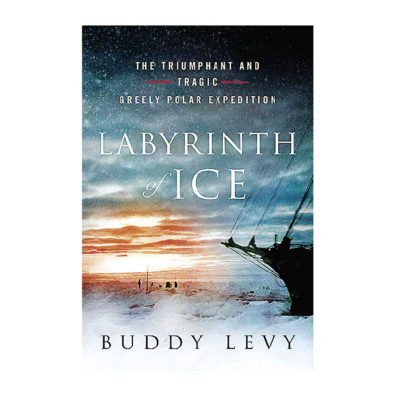
Arctic


Empire of Ice and Stone: A chat with author Buddy Levy
The treacherous Arctic is the setting of a harrowing true story of shipwreck, disaster, and survival in the early twentieth century. Acclaimed adventure writer Buddy Levy, also a creative writing and English professor at Washington State University, talks with Washington State Magazine associate editor Adriana Janovich about his latest book, Empire of Ice and Stone: The Disastrous and Heroic Voyage of the Karluk.
The second of three nonfiction historical narratives by master storyteller Levy about survival and exploration in the Arctic wilderness, this book tracks the voyage of the Karluk to the Bering Sea and its destruction in the ice, leaving crew, Inuit guides, and … » More …

Labyrinth of Ice: The Triumphant and Tragic Greely Polar Expedition
Buddy Levy
St. Martin’s Press: 2019
Lt. Adolphus W. Greely, commander of the Lady Franklin Bay Expedition, assessed the situation from the edge of the ice floe upon which he and his men were stranded.
It was dire.
They were adrift on a raft of ice, and it was 11 degrees Fahrenheit—cold for the time of year but not as low as the sub-zero temperatures they regularly experienced during their two years of exploration and data collection, … » More …

Q&A: Buddy Levy on the art and craft of the historical narrative
Buddy Levy likes to make the trip.
He specializes in historical narrative, paying meticulous attention to detail, writing cinematically, and traveling to the sites of the stories he’s researching—sometimes several hundred years after they’ve occurred. Travel, he says, is necessary for scene-setting and description, and can be more meaningful than archival research.
His seventh book, Labyrinth of Ice, started with a visit to Greenland in 2003. But he was there to write about something else. Levy was covering a race in which Erik Weihenmayer, the first blind man to summit Mount Everest, was competing, and he managed to convince Weihenmayer to let … » More …
Arctic chronicles
Video: Archiving Ice
Archiving Ice.
Caroline Landau
Svalbard and San Francisco 2017–2018
During the Arctic Circle Artist Residency in October 2017, Caroline made molds from “bergy bits” (small icebergs from calved glaciers). She painted melted wax on individual pieces of ice that washed upon the shores of Bloomstrandbreen, Svalbard in Spitsbergen. Read more on Caroline’s website.
An essay in the Spring 2019 issue by WSU Regents professor of English Debbie Lee describes the work and impact of the Artist Residency: Arctic chronicles
Gallery: Arctic journey
Writer and Washington State University Regents professor of English Debbie Lee traveled to Svalbard in the Arctic aboard the tall ship Antigua, as part of the Arctic Circle Artist Residency Program. Follow the journey through Lee’s photographs below, and read her essay, “Arctic chronicles,” in the Spring 2019 issue.

Bear watching
The headlines paint a dire picture: By the 2030s, global warming could completely melt Arctic sea ice, imperiling the 19 known polar bear populations that range across the United States, Canada, Russia, Greenland, and Norway.
Could, as some fear, the trend spell extinction for Ursus martimus?
For two of the country’s premiere polar bear researchers—wildlife biologists KARYN RODE ’99 MS, ’05 PhD, and DAVID C. DOUGLAS ’86 MS, both of whom work for the U.S. Geological Survey’s Alaska Science Center—the answer is a decided “No.”
But neither is the future rosy for the animals, according to Douglas, who uses satellite tracking to monitor their … » More …

Thin ice
Being put to the test at the ground zero of climate change
There’s the day the polar bear mangled the meteorological instruments. Or when a massive storm smashed two humidity sensors. Days of howling winds, extremely limited visibility, and weather so cold that power cords snapped like twigs.
For Von P. Walden, a professor in Washington State University’s Department of Civil and Environmental Engineering, the most exciting day as part of the Norwegian Young Sea ICE Cruise (N-ICE2015) team was last May when the thin layer of Arctic sea ice on which the researchers were working started breaking up.
Wearing a Regatta suit … » More …

